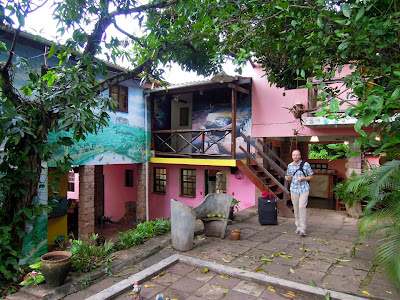Itaparica isn’t a resort island. There’s a Club Med situated on the southern coast, taking up the island’s best beach, and catering to wealthier tourists. Other than that, the island is largely residential, underdeveloped, and impoverished. But what Itaparica lacks in glamour, it makes up for in a kind of rustic, natural beauty.
Getting there was a 45-minute ferry ride from Salvador, then a 20-minute taxi to Itaparica City on the north shore. Sean was on the tail end of his three-month residency at Sacatar, an institute that brings in artists from around the world. I had booked a room at a pousada a short walk from the institute called the Muita Mais (“Much More”) run by a young South African/Brazillian couple. The Brazillian half of the couple, Daniel, was incredibly energetic and friendly. The Pousada was once his grandfather’s home, a deep sea fisherman whose younger self can be seen grinning next to human-sized fish in fading photographs lining the wall. The property is surrounded by thick jungle with a bunch of tropical fruit trees. And cocoa. Daniel harvests it, grinds it with a homemade contraption made out of bicycle parts and other metal bits, and then roasts it into chocolate. He had me sample some of his current batch which was strong, dark and somewhat bitter. I liked it enough to buy some to share with family and friends back home. The South African half of the couple, Natalie, moved to the island with her parents a couple years ago before meeting Daniel. I loved her accent. She, like Daniel, was very welcoming and easy to talk to.
I attended Sean’s capoeira class the first night on the island, purely as a spectator. As inflexible as I am, I doubt I can kick any higher than my thigh. It was entertaining to watch those more talented than I, especially the advanced class, as they kicked and twisted and ducked and danced to the live drums and singing.
I made my way to Sacatar the next day for lunch and a tour of the institute. The eight artists currently in residence were a fortunate bunch. The institute is a lovely, relaxing place, with shaded walkways, ocean breezes, small green ponds, and individual studios where each artist has space to create. I met the artists as we walked the grounds. There was a lot of variety in their disciplines: from painters, to found-object sculptors, to a stained-glass maker. Sean had spent his time writing a new play and learning woodcarving under the direction of a local wood-worker.
That afternoon, while Sean was in the workshop, I carried a kayak through the gate leading onto the sandy beach. The ocean there was shallow and I had to drag the kayak pretty far out before it was deep enough to clumsily pull myself into. There weren’t really waves of note, but it was intensely windy and hot. The sunscreen on my forehead kept melting into my eyes, so I navigated half-blind along the little bay. Still, it was pleasant, rocking gently in the water, squinting at the circling birds, and watching kids play in the distance.
I spent the rest of the day on a hammock, reading in the warm breeze. In the evening we dined at a small market near the pousada, then in the early morning I strolled the waterfront, weaving into narrow alleyways lined with small shops, flaking plaster buildings, churches, and an old fort. Compared to Salvador, Itaparica seemed a ghost village. Everything was quiet and seemingly deserted throughout most of the day. In the high tourist season, that apparently changes, but at the cusp of summer, the main populace was still mostly ghosts.





























































